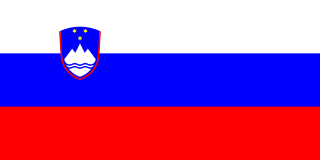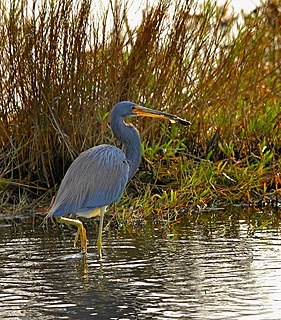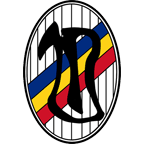
The national flag of Slovenia features three equal horizontal bands of white (top), blue, and red, with the Coat of arms of Slovenia located in the upper hoist side of the flag centered in the white and blue bands. The coat of arms is a shield with the image of Mount Triglav, Slovenia's highest peak, in white against a blue background at the center; beneath it are two wavy blue lines representing the Adriatic Sea and local rivers, and above it are three six-pointed golden stars arranged in an inverted triangle which are taken from the coat of arms of the Counts of Celje, the great Slovene dynastic house of the late 14th and early 15th centuries.
Tricolor or tricolour, or tricolored, tricoloured, may refer to:

The flag of Afghanistan consists of a white field with a black Shahada. It is also the flag of the Taliban, which has led the government since 2021. Afghanistan has had 25 national flags since the first flag when the Hotak dynasty was established in 1709. During the 20th century alone, Afghanistan went through 19 national flags, more than any other country during that time period, and most of them had three colors: black, red, and green.

The tricolored heron, formerly known as the Louisiana heron, is a small species of heron native to coastal parts of the Americas; in the Atlantic region, it ranges from the northeastern United States, south along the coast, through the Gulf of Mexico and the Caribbean, to northern South America as far south as Brazil. In the Pacific region, it ranges from Peru to California, but it is only a nonbreeding visitor to the far north.

Viola tricolor is a common European wild flower, growing as an annual or short-lived perennial. The species is also known as wild pansy, Johnny Jump up, heartsease, heart's ease, heart's delight, tickle-my-fancy, Jack-jump-up-and-kiss-me, come-and-cuddle-me, three faces in a hood, love-in-idleness, and pink of my john.

The tricolored bat is a species of microbat native to eastern North America. Formerly known as the eastern pipistrelle, based on the errant belief that it was closely related to European Pipistrellus species, the closest known relative of the tricolored bat is now recognized as the canyon bat. Its common name "tricolored bat" derives from the coloration of the hairs on its back, which have three distinct color bands. It is the smallest bat species in the eastern and midwestern US, with individuals weighing only 4.6–7.9 g (0.16–0.28 oz). This species mates in the fall before hibernation, though due to sperm storage, females do not become pregnant until the spring. Young are born helpless, though rapidly develop, flying and foraging for themselves by four weeks old. It has a relatively long lifespan, and can live nearly fifteen years.

Unirea Tricolor București was a Romanian football club from Bucharest, south-east Romania, founded in 1914 as Tricolor București. It was one of the most famous inter-war clubs in Romania.
A triband is a vexillological style which consists of three stripes arranged to form a flag. These stripes may be two or three colors, and may be charged with an emblem in the middle stripe.

In the mathematical field of knot theory, the tricolorability of a knot is the ability of a knot to be colored with three colors subject to certain rules. Tricolorability is an isotopy invariant, and hence can be used to distinguish between two different (non-isotopic) knots. In particular, since the unknot is not tricolorable, any tricolorable knot is necessarily nontrivial.
The hybrid elm cultivar Ulmus × hollandica 'Tricolor' was first listed as U. suberosa tricolor by C. de Vos in 1867.

Tricolor TV is Russia's largest direct-to-home provider based in Saint-Petersburg and has broadcast two hundred TV channels in the European part of Russia and Siberia since 2005. As of October 2014, Tricolor TV provided satellite services to over fifteen million subscribers.

Nemophas is a genus of longhorn beetles of the subfamily Lamiinae, containing the following species:
Nemophas grayii is a species of beetle in the family Cerambycidae. It was described by Francis Polkinghorne Pascoe in 1859, originally under the genus Monohammus. It is known from Moluccas.

Nemophas incensus is a species of beetle in the family Cerambycidae. It was described by Francis Polkinghorne Pascoe in 1866. It is known from Moluccas.
Nemophas leuciscus is a species of beetle in the family Cerambycidae. It was described by Francis Polkinghorne Pascoe in 1866. It is known from Moluccas.
Nemophas nigriceps is a species of beetle in the family Cerambycidae. It was described by Vitali in 2013. It is known from Sulawesi.

Nemophas ramosi is a species of beetle in the family Cerambycidae. It was described by Schultze in 1920, originally as a subspecies of Nemophas rosenbergii. It is known from the Philippines.
Nemophas tomentosus is a species of beetle in the family Cerambycidae. It was described by Buquet in 1859, originally under the genus Apriona. It is known from the Solomon Islands and Papua New Guinea.
Nemophas zonatus is a species of beetle in the family Cerambycidae. It was described by Lansberge in 1880. It is known from Indonesia.











